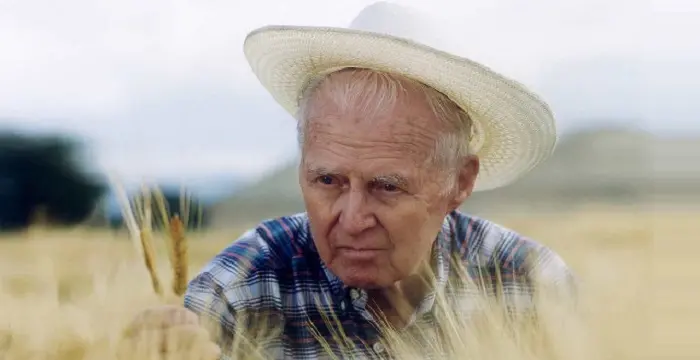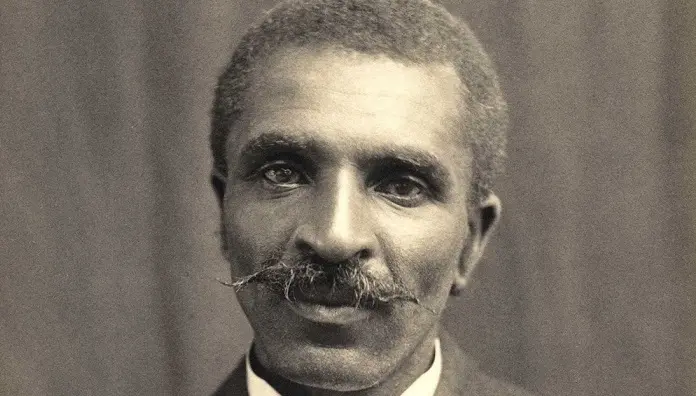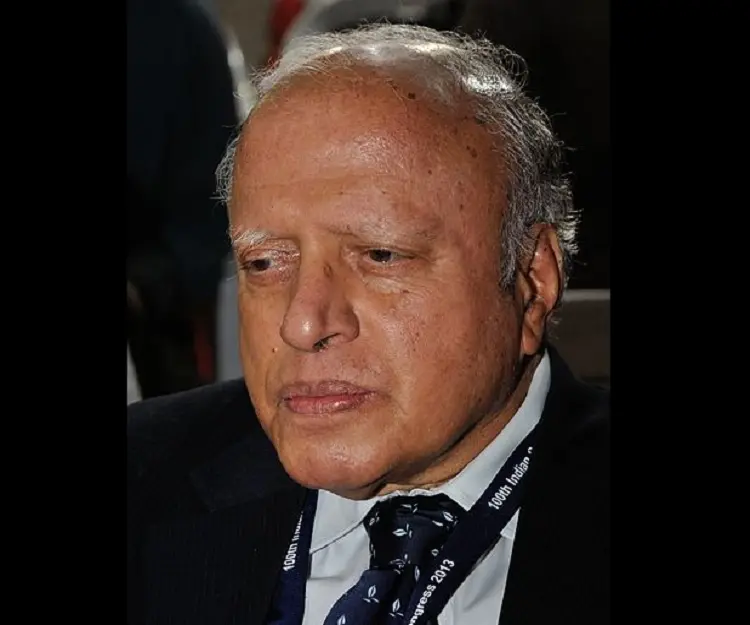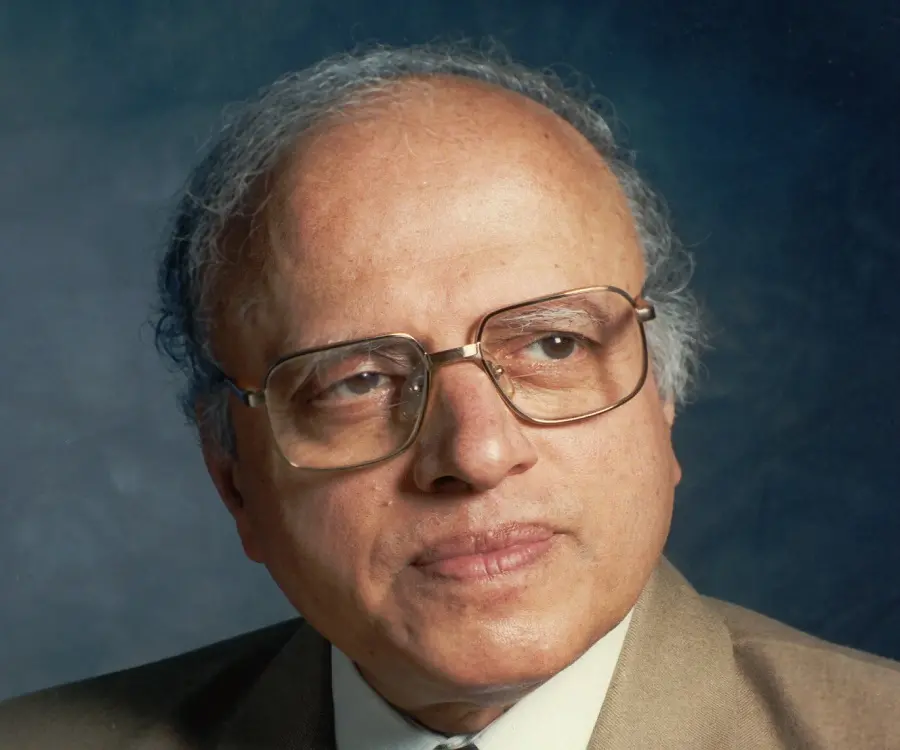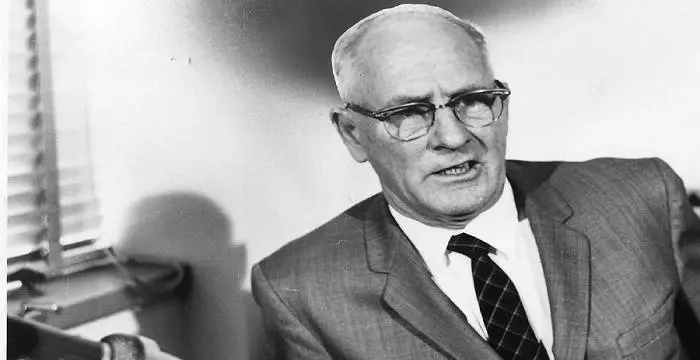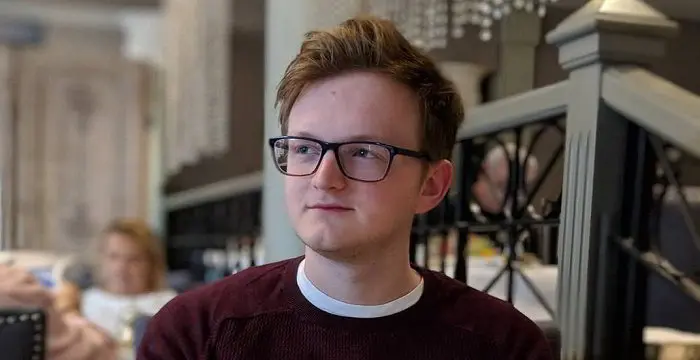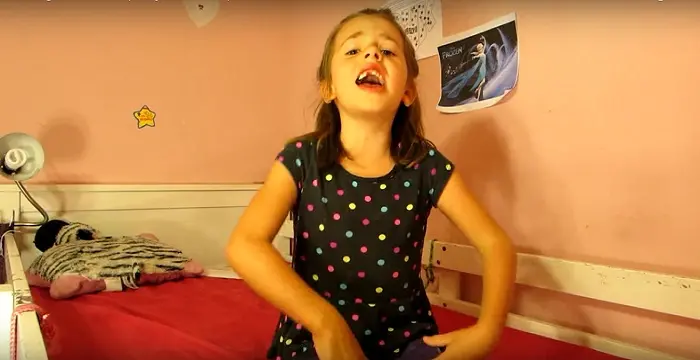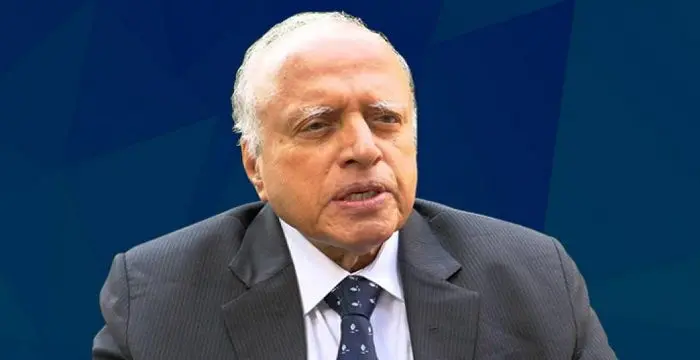
M. S. Swaminathan - Geneticists, Birthday and Personal Life
M. S. Swaminathan's Personal Details
Dr
| Information | Detail |
|---|---|
| Birthday | August 7, 1925 |
| Nationality | Indian |
| Famous | Scientists, Agricultural Scientists, Geneticists |
| Known as | Prof. M.S. Swaminathan, Mankombu Sambasivan Swaminathan, Father of the Green Revolution in India, Monkombu Sambasivan Swaminathan |
| Universities |
|
| Founder / Co-Founder |
|
| Birth Place | Kumbakonam |
| Religion | Hindu |
| Gender | Male |
| Father | M.K. Sambasivan |
| Mother | Parvati Thangammal Sambasivan |
| Sun Sign | Leo |
| Born in | Kumbakonam |
| Famous as | Agricultural Scientist |
// Famous Agricultural Scientists
Norman Borlaug
Norman Borlaug was an American biologist known as the “Father of the Green Revolution”. This biography of Norman Borlaug provides detailed information about his childhood, life, achievements, works & timeline.
George Washington Carver
George Washington Carver was an American scientist and inventor. This biography provides detailed information about his childhood, life, achievements and timeline.
M. S. Swaminathan's photo
Who is M. S. Swaminathan?
Dr. M.S. Swaminathan is a renowned Indian geneticist and administrator, who made a stellar contribution in the success of India's Green Revolution program; the program went a long way in making India self-sufficient in wheat and rice production. He was deeply influenced by his father who was a surgeon and social reformer. After graduating in zoology, he enrolled in Madras Agricultural College and graduated with a B.Sc. in Agricultural Science. His choice of career as a geneticist was influenced by the great Bengal famine of 1943 during which scarcity of food resulted in many deaths. Philanthropic by nature, he wanted to help poor farmers increase their food production. He began his career by joining the Indian Agricultural Research Institute in New Delhi and eventually played the lead role in India’s ‘Green Revolution’, an agenda under which high-yielding varieties of wheat and rice saplings were distributed to poor farmers. In the decades that followed, he held research and administrative positions in various offices of Government of India and introduced the Mexican semi dwarf wheat plants as well as modern farming methods in India. He has been acclaimed by the TIME magazine as one of the twenty most influential Asians of the twentieth century. He has also been honoured with several national and international awards for his contribution to the field of agriculture and biodiversity.
// Famous Scientists
Juliane Koepcke
Juliane Koepcke is a German-Peruvian biologist, who was the lone survivor among the 92 passengers and crew of the ill-fated LANSA Flight 508 that crashed in the Peruvian rainforest on 24 December 1971. Know more about her life in this biography.
Henry Cavendish
Henry Cavendish was a theoretical chemist and physicist, renowned for discovery of hydrogen and calculation of the mass of earth. To know more about his childhood, profile, timeline and career read on
Konstantin Tsiolkovsky
Konstantin Tsiolkovsky was a Russian rocket scientist and a pioneer of astronautics. This biography provides detailed information about his childhood, family, personal life, career, achievements, etc.
Childhood & Early Life
Dr. Swaminathan was born on 7 August, 1925 in Kumbakonam, Madras Presidency, to Dr. M.K. Sambasivan and Parvati Thangammal Sambasivan . His father was a surgeon and social reformer.
He lost his father at the age of 11 and thereafter he was brought up by his uncle, M. K. Narayanaswami who was a radiologist. He studied at Little Flower High School in Kumbakonom and later at Maharajas College in Trivandrum. He graduated in 1944 with a degree in zoology.
Career
The Bengal famine of 1943 motivated him to pursue a career in agricultural sciences. Hence, he enrolled in Madras Agricultural College and completed his B.Sc. in Agricultural Science.
In 1947, he joined the Indian Agricultural Research Institute (IARI), New Delhi and completed his post-graduation in genetics and plant breeding in 1949. He received a UNESCO Fellowship and went to Wageningen Agricultural University, Institute of Genetics in the Netherlands. There, he continued his IARI research on potato genetics and was successful in standardising procedures for transferring genes from a wide range of wild species of Solanum to the cultivated potato, Solanum tuberosum.
In 1950, he joined the School of Agriculture, University of Cambridge, U.K. and earned his PhD in 1952 for the thesis titled “Species Differentiation and the Nature of Polyploidy in certain species of the genus Solanum – section Tuberarium.”
He then became a post-doctoral researcher at the University of Wisconsin, U.S.A. He was offered a full time faculty position at the university; he refused it and returned to India in early 1954.
From 1954 to 66, he was a teacher, researcher and research administrator at the Indian Agricultural Research Institute (IARI), New Delhi. He became the Director of IARI in 1966 and continued till 1972. Meanwhile, he was also associated with the Central Rice Research Institute at Cuttack, from 1954–72.
From 1971–77, he was a member of the National Commission on Agriculture. From 1972–79, he was Director-General of Indian Council of Agricultural Research (ICAR) under Government of India.
From 1979–80 he was Principal Secretary in the Ministry of Agriculture and Irrigation, Government of India. In mid 1980s, he also acted as Deputy Chairman of Planning Commission of India.
From June 1980 to April 1982, he was a member of Planning Commission – (Agriculture, Rural Development, Science and Education) of India. At the same time, he was also Chairman of Science Advisory Committee to the Cabinet of India.
In 1981, he became the Chairman of Working Group on Control of Blindness and Chairman of Working Group on Control of Leprosy. From 1981-82, he was Chairman of National Biotechnology Board. From 1981–85, he was Independent Chairman of Food and Agriculture Organization (FAO) Council.
From April 1982 to January 1988, he was Director-General of International Rice Research Institute (IRRI), Philippines. From 1988-89, he was Chairman of Steering Committee for Environment and Forestry of the Planning Commission. From 1988–96, he was President, of World Wide Fund for Nature–India.
From 1984–90, he was President of the International Union for Conservation of Nature and Natural Resources.
From 1986–99, he was Chairman of the editorial advisory board, World Resources Institute, Washington, D. C. He conceived the first ‘World Resources Report’.
From 1988–99, he was Chairman of Commonwealth Secretariat Expert Group. He organised the Iwokrama International Centre for Rainforest Conservation and Development.
From 1988–98, he was Chairman of various committees of the Government of India to prepare draft legislations related to Biodiversity Act.
From 1989-90, he was Chairman of the Core Committee for the preparation of a National Environment Policy under Government of India. He was also Chairman of High Level Committee for the review of the Central Ground Water Board. 1989 onwards, he was Chairman of M.S. Swaminathan Research Foundation.
In 1993–94, he was Chairman of Expert Group for the preparation of a draft National Population Policy. 1994 onwards, he was UNESCO Chair in Ecotechnology at M.S. Swaminathan Research Foundation, Chennai.
In 1994, he was Chairman of the Commission on Genetic Diversity of the World Humanity Action Trust. He also became Chairman of the Genetic Resources Policy Committee of the Consultative Group on International Agricultural Research.
From 1994 to 1997, he was Chairman of Committee for Research on Agricultural Exports in the context of the World Trade Agreement, Government of India. From 1996-97, he was Chairman of Committee to restructure agricultural education.
From 1996–98, he was Chairman of Committee on Remedying Regional Imbalances in Agriculture, Government of India.
In 1998, he was Chairman of Committee to draft a National Biodiversity Act. In 1999, he implemented the Gulf of Mannar Biosphere Reserve Trust. From 2000–2001 he was Chairman of the Tenth Plan Steering Committee in the area of Agriculture and allied sectors.
From 2002–2007, he was President of the Pugwash Conferences on Science and World Affairs. In 2004, he was Chairman of the Task Force for a National Policy for Agricultural Biotechnology. From 2004–06, he was Chairman of the National Commission on Farmers, Government of India.
In 2005, he was Chairman of the Expert Group for a Review of Coastal Zone Regulation, and Chairman of the Task Group on Revamping and Re-focussing National Agricultural Research System.
In April 2007, he was nominated to Rajya Sabha. From August 2007 to May 2009 and August 2009 to August 2010, he was a member of Committee on Agriculture.
August 2007 onwards, he has been a member of the Consultative Committee for the Ministry of Agriculture, UNESCO-Cousteau Professor in Ecotechnology for Asia, Adjunct Professor in the field of Ecotechnology at Centre for Advanced Study in Botany, University of Madras, and IGNOU Chair on Sustainable Development.
August 2010 onwards, he has been a member of the Indian Council of Agriculture Research Society and September 2010 onwards, he has been a member of the Committee on Science and Technology, Environment and Forests.
Presently, he is also a member of the Leadership Council of Compact 2025, an organization that guides decision-makers at eradicating malnutrition in the next decade.
Major Works
Dr. Swaminathan is celebrated as the leader of India’s ‘Green Revolution’ program. He is also a resourceful writer. He has written several research papers and books on Agricultural Science and Biodiversity like ‘Building a National Food Security System, 1981’, ‘Sustainable Agriculture: Towards an Evergreen Revolution, 1996’, etc.
Awards & Achievements
Dr. Swaminathan has received several awards for his contribution to the field of Agricultural Science. He has received the prestigious Ramon Magsaysay Award for Community Leadership in 1971, the Albert Einstein World Science Award in 1986, the UNESCO Mahatma Gandhi Prize in 2000, and the Lal Bahadur Sastri National Award in 2007, among other achievements.
He is the recipient of national honours like Padma Shri in 1967, Padma Bhushan in 1972 and Padma Vibushan in 1989. Moreover, he has received over 70 honorary PhD degrees from world-wide universities.
Personal Life & Legacy
Dr. Swaminathan is married to Mrs Mina Swaminathan since 11 April, 1955. The couple has three daughters together.
// Famous Geneticists
Norman Borlaug
Norman Borlaug was an American biologist known as the “Father of the Green Revolution”. This biography of Norman Borlaug provides detailed information about his childhood, life, achievements, works & timeline.
George Wells Beadle
George Wells Beadle was an American geneticist who won the 1958 Nobel Prize in Medicine. Check out this biography to know about his childhood, life, achievements, works & timeline.
Gregor Mendel
Gregor Mendel was an Austrian scientist and monk credited with being the father of modern genetics for his pioneering work in the study of heredity. This biography provides detailed information about his childhood, life, achievements, & timeline.
M. S. Swaminathan's awards
| Year | Name | Award |
|---|---|---|
Other | ||
| 2010 | CNN-IBN Indian of the Year Lifetime Achievement | |
| 1986 | Albert Einstein World Award of Science | |
| 0 | 1987 - World Food Prize | |
| 0 | 2013 - Indira Gandhi Award for National Integration | |
| 0 | 1999 - Indira Gandhi Prize | |
M. S. Swaminathan biography timelines
- // 7th Aug 1925Dr. Swaminathan was born on 7 August, 1925 in Kumbakonam, Madras Presidency, to Dr. M.K. Sambasivan and Parvati Thangammal Sambasivan . His father was a surgeon and social reformer.
- // 1943The Bengal famine of 1943 motivated him to pursue a career in agricultural sciences. Hence, he enrolled in Madras Agricultural College and completed his B.Sc. in Agricultural Science.
- // 1944He lost his father at the age of 11 and thereafter he was brought up by his uncle, M. K. Narayanaswami who was a radiologist. He studied at Little Flower High School in Kumbakonom and later at Maharajas College in Trivandrum. He graduated in 1944 with a degree in zoology.
- // 1947 To 1949In 1947, he joined the Indian Agricultural Research Institute (IARI), New Delhi and completed his post-graduation in genetics and plant breeding in 1949. He received a UNESCO Fellowship and went to Wageningen Agricultural University, Institute of Genetics in the Netherlands. There, he continued his IARI research on potato genetics and was successful in standardising procedures for transferring genes from a wide range of wild species of Solanum to the cultivated potato, Solanum tuberosum.
- // 1950 To 1952In 1950, he joined the School of Agriculture, University of Cambridge, U.K. and earned his PhD in 1952 for the thesis titled “Species Differentiation and the Nature of Polyploidy in certain species of the genus Solanum – section Tuberarium.”
- // 1954He then became a post-doctoral researcher at the University of Wisconsin, U.S.A. He was offered a full time faculty position at the university; he refused it and returned to India in early 1954.
- // 11th Apr 1955Dr. Swaminathan is married to Mrs Mina Swaminathan since 11 April, 1955. The couple has three daughters together.
- // 1971 To 1972From 1971–77, he was a member of the National Commission on Agriculture. From 1972–79, he was Director-General of Indian Council of Agricultural Research (ICAR) under Government of India.
- // 1979From 1979–80 he was Principal Secretary in the Ministry of Agriculture and Irrigation, Government of India. In mid 1980s, he also acted as Deputy Chairman of Planning Commission of India.
- // Jun 1980 To Apr 1982From June 1980 to April 1982, he was a member of Planning Commission – (Agriculture, Rural Development, Science and Education) of India. At the same time, he was also Chairman of Science Advisory Committee to the Cabinet of India.
- // 1981 To 1996Dr. Swaminathan is celebrated as the leader of India’s ‘Green Revolution’ program. He is also a resourceful writer. He has written several research papers and books on Agricultural Science and Biodiversity like ‘Building a National Food Security System, 1981’, ‘Sustainable Agriculture: Towards an Evergreen Revolution, 1996’, etc.
- // 1984From 1984–90, he was President of the International Union for Conservation of Nature and Natural Resources.
- // 1986From 1986–99, he was Chairman of the editorial advisory board, World Resources Institute, Washington, D. C. He conceived the first ‘World Resources Report’.
- // 1988From 1988–99, he was Chairman of Commonwealth Secretariat Expert Group. He organised the Iwokrama International Centre for Rainforest Conservation and Development.
- // 1988From 1988–98, he was Chairman of various committees of the Government of India to prepare draft legislations related to Biodiversity Act.
- // 1989From 1989-90, he was Chairman of the Core Committee for the preparation of a National Environment Policy under Government of India. He was also Chairman of High Level Committee for the review of the Central Ground Water Board. 1989 onwards, he was Chairman of M.S. Swaminathan Research Foundation.
- // 1993 To 1994In 1993–94, he was Chairman of Expert Group for the preparation of a draft National Population Policy. 1994 onwards, he was UNESCO Chair in Ecotechnology at M.S. Swaminathan Research Foundation, Chennai.
- // 1994In 1994, he was Chairman of the Commission on Genetic Diversity of the World Humanity Action Trust. He also became Chairman of the Genetic Resources Policy Committee of the Consultative Group on International Agricultural Research.
- // 1996From 1996–98, he was Chairman of Committee on Remedying Regional Imbalances in Agriculture, Government of India.
- // 2005In 2005, he was Chairman of the Expert Group for a Review of Coastal Zone Regulation, and Chairman of the Task Group on Revamping and Re-focussing National Agricultural Research System.
- // Aug 2007August 2007 onwards, he has been a member of the Consultative Committee for the Ministry of Agriculture, UNESCO-Cousteau Professor in Ecotechnology for Asia, Adjunct Professor in the field of Ecotechnology at Centre for Advanced Study in Botany, University of Madras, and IGNOU Chair on Sustainable Development.
- // Sep 2010August 2010 onwards, he has been a member of the Indian Council of Agriculture Research Society and September 2010 onwards, he has been a member of the Committee on Science and Technology, Environment and Forests.
// Famous Leo Celebrities peoples
Eugenia Cooney
Check out all that you wanted to know about Eugenia Cooney, the famous American Vlogger & YouTube Personality; her birthday, her family and personal life, her boyfriends, fun trivia facts and more.
Princess D
Princess D (Destiny Indira Cox) is an American rapper, dancer and social media personality. Let’s have a look at her family and personal life including age, birthday, net worth, and fun facts.
Payton Moormeier
Payton Moormeier is an American social-media personality best known for his musical.ly videos. Check out this family, personal life, etc.
Grian
Grian is an English YouTube gamer and social media influencer. Check out this biography to know about his birthday, childhood, family life, achievements and fun facts about him.
Emmi Butler
Emmi Butler is an American YouTuber and social media star. Let’s take a look at her family and personal life including age, date of birth, net worth, and fun facts.
Erica Delsman
Erica Delsman is an American Musical.ly Star and social media personality. Let’s take a look at her family & personal life including age, date of birth, net worth, and fun facts.
M. S. Swaminathan's FAQ
What is M. S. Swaminathan birthday?
M. S. Swaminathan was born at 1925-08-07
Where is M. S. Swaminathan's birth place?
M. S. Swaminathan was born in Kumbakonam
What is M. S. Swaminathan nationalities?
M. S. Swaminathan's nationalities is Indian
What was M. S. Swaminathan universities?
M. S. Swaminathan studied at Tamil Nadu Agricultural University, University of Wisconsin-Madison, University of Cambridge, Maharaja's College, Ernakulam
Which company or organization was founded by M. S. Swaminathan?
M. S. Swaminathan was the founder/co-founder of MS Swaminathan Research Foundation
What is M. S. Swaminathan's religion?
M. S. Swaminathan's religion is Hindu
Who is M. S. Swaminathan's father?
M. S. Swaminathan's father is M.K. Sambasivan
Who is M. S. Swaminathan's mother?
M. S. Swaminathan's mother is Parvati Thangammal Sambasivan
What is M. S. Swaminathan's sun sign?
M. S. Swaminathan is Leo
How famous is M. S. Swaminathan?
M. S. Swaminathan is famouse as Agricultural Scientist
